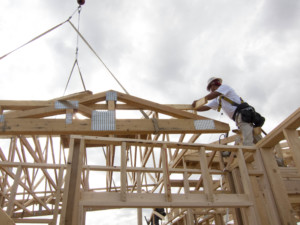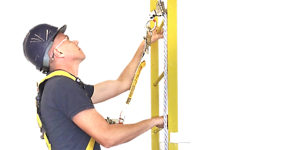Working at Heights Courses in Ontario for Construction
Did you know that Ontario companies spent $52M paying for work-related compensation and other losses in 2015, on workplace fall injuries alone? Working at Heights training is important to keep all workers safe, and it is required by the law. If you want to learn how to decrease and prevent the amount you spend on workplace injury, contact ACUTE today.
Working at Heights Courses
Working at Heights (CPO approved) – Required For Construction Workers
Course Length: 1 day (8 hours)
 ACUTE’s Working at Heights course combines both theory and hands-on, practical training for an optimal learning experience. This program aims to strengthen workplace safety culture, provide knowledge on how to prevent accidents, provide information about proper use of safety equipment, and overall reduce the number of workplace falls and incidents.
ACUTE’s Working at Heights course combines both theory and hands-on, practical training for an optimal learning experience. This program aims to strengthen workplace safety culture, provide knowledge on how to prevent accidents, provide information about proper use of safety equipment, and overall reduce the number of workplace falls and incidents.
ACUTE’s Working at Height training program has been approved by the Chief Prevention Officer under the Ministry of Labour, Immigration, Training and Skills Development’s Working at Heights Training Program Standard and the Working at Heights Training Provider Standard.
Fall Protection
Course Length: Half day (4 hours)
 This training course is geared towards those working at height in Industrial Establishments, Mining Operations, Health Care and Residential Facilities sectors, or other workplaces that are not Construction Projects. This flexible training course can be modified to best suit your specific industry’s needs, and to address workplace specific equipment. This course includes hands-on training, detailed videos, handouts, quizzes, and classroom interaction with experienced instructors.
This training course is geared towards those working at height in Industrial Establishments, Mining Operations, Health Care and Residential Facilities sectors, or other workplaces that are not Construction Projects. This flexible training course can be modified to best suit your specific industry’s needs, and to address workplace specific equipment. This course includes hands-on training, detailed videos, handouts, quizzes, and classroom interaction with experienced instructors.
Scaffolding and Ladder
Course Length: 2 hours
 This course focuses on the dangers of working at heights from a scaffold or ladder, and how to prevent accidents and incidents. Our Scaffolding and Ladder course teaches participants how to work safely, including how to properly dismantle them after use. Participants will learn how to properly identify workplace hazards related to scaffolding and ladders, how to identify safe scaffold setups, how to identify different types of ladders, and understanding legislation.
This course focuses on the dangers of working at heights from a scaffold or ladder, and how to prevent accidents and incidents. Our Scaffolding and Ladder course teaches participants how to work safely, including how to properly dismantle them after use. Participants will learn how to properly identify workplace hazards related to scaffolding and ladders, how to identify safe scaffold setups, how to identify different types of ladders, and understanding legislation.

This resource page outlines ACUTE’s free online Working at Heights training resources. From fall protection to statistics to industry specific training information, this page has everything you need to know about online training. We also outline the issues, misconceptions, and limitations associated with online learning, and emphasize the importance of a hands-on, in-class training environment.
For more detailed information about the different levels of Working at Heights training, click here.
Working at Heights Course Content
ACUTE’s CPO approved Working at Heights course provides workers with both the theoretical and practical knowledge needed to work safely at heights. Some components included in the course:
- Ladder safety
- Fall protection systems & fall prevention strategies
- Harness inspection, fitting exercises, and evaluation
- Rescue plans
- Learning about WAH hazards
- WAH legislation
- And more!
Why Are Working at Heights Courses Important?

All you have to do is read the news to see why Working at Heights courses are so important. Unfortunately, working at heights accidents occur on a regular basis. According to OHS Canada (Canada’s Occupational Health & Safety Magazine), over 40,000 people are injured each year in Canada due to fall accidents. In 2013, 10 workers died in Ontario from worksite falls.
Why do falls continue to happen at such a high rate? OHS outlines the following main reasons:
- Poor working conditions: slippery surfaces, poor visibility or lighting, or poor housekeeping practices
- Lack of guardrails or other protective equipment
- Ladders and/or scaffolding are not used properly or are in poor condition
- Fall protection equipment is misused, not used, or not available at all
- Poor worker practices due to lack of training, taking short cuts, or unclear job expectations/procedures
Source: OHS Canada – People Are Falling – Statistics Are Not
In August 2016, CBC News Toronto reported on a construction site fatality. A worker fell from a height of more than 10 meters off a roof and was pronounced dead at the scene.
On March 2, 2017, the Journal of Commerce reported on another Canadian construction worker death in Victoria, B.C. 51-year-old Roland Huetzelmann fell three floors from a construction site. The day of this experienced construction worker’s death was reported to have winds of approximately 55 km/hr. Many wondered why construction work was not halted during these poor working conditions. Others reported that guardrails and proper safety harnesses were not used as they should have been on that construction site.
“The brother of a construction worker who fell 35 feet says his death was not a freak accident. ‘It was 100 per cent preventable,’ said Joe Huetzelmann. ‘I’m going to try to do justice for my brother. I have family looking to me for answers. They want to know what happened.'”
Though new workers are more likely to get injured on the job, experienced workers are also at risk. It is important that experienced workers remain up to date on best safety practices both for their own safety and for younger and less experienced workers who look up to them as role models.
Cutting Corners – Safety, Time, and Cost Constraints
Like the OHS Canada article and Journal of Commerce news clip above outlines, many accidents happen due to cutting corners and caring more about saving time and costs than workplace safety.
“The night before the fall, Desjarlais
[Roland’s girlfriend] and Roland discussed the forecasted windy weather for the following day. Desjarlais questioned why work wasn’t stopped with predicted winds of 60 km/h.”
“Roland agreed. But they’ve got their timelines. Somebody’s dead because of those deadlines,” [Desjarlais] said.”
 With the new Working at Heights training requirement deadline coming up, many employers and workers agree that there is a need for training, but there is not total agreement about who should pay for the training and who should be required to participate.
With the new Working at Heights training requirement deadline coming up, many employers and workers agree that there is a need for training, but there is not total agreement about who should pay for the training and who should be required to participate.
Many believe that training should be for new workers only, and that experienced workers should not have to undergo the new training requirements. However, as the Roland Huetzelmann case shows, accidents, injuries, and even fatalities can happen to even the most experienced workers.
Others believe that e-learning is the best way to go. However, as we’ve outlined in our Issues and Limitations with Online Working at Heights Training in Ontario article, online learning cannot replace hands-on, practical learning. E-learning would cut the training costs, which is a major concern for employers right now, but is it worth possibly putting more workers at risk due to incomplete training?
Skipping out on proper Working at Heights training may seem attractive to employers, and even to workers who feel they already know everything there is to know. However, compensation, fines, and other expenses will end up costing an employer more than what it takes to provide proper Working at Heights training for their employees.
Source: Daily Commerce News – New Mandatory Safety Training for Construction Sites Looming
Solutions: Ensuring Safety In The Workplace

Here are some easy solutions to ensure both the safety of workers and reduction of costs without cutting corners.
- Use online training as an addition to practical classroom training – additional training can help prevent accidents and ensure workers really know their stuff!
- Employers should become familiar with all legislation, codes, and standards.
- Train employees to look out for and deal with fall hazards, how to properly clean up spills, and how to use their safety equipment.
- Train employees to recognize unsafe working conditions, and remind them it is their duty to report all unsafe conditions to their employer or supervisor.
- If an accident, incident, or close call occurs, investigate immediately to prevent another from happening.
- Continuously evaluate the safety of the worksite and properly supervise workers.
Source: ohscanada.com
Training With ACUTE
The best way to ensure safety in the workplace for all those involved is to provide workers with proper training. ACUTE is dedicated to providing excellent Working at Heights training that does not cut corners but instead provides workers with knowledge and know-how when it comes to Working at Heights best safety practices. Here are some of the training differences when working with ACUTE:
- Open Door Instructor-Student Par
 tnership – ACUTE’s training services emphasize client participation. Staff want to build a relationship with clients and serve as a touchstone for advice anytime moving forward.
tnership – ACUTE’s training services emphasize client participation. Staff want to build a relationship with clients and serve as a touchstone for advice anytime moving forward. - Serving Your Team and Industry – With a vast array of clients in manufacturing, construction, health, academic, and government sectors, ACUTE brings the best safety practices from across the spectrum to your workplace.
- 100 Years Combined Experience – ACUTE provides comprehensive health and safety training, on-site safety services, and consulting services. With over 100 years of combined experience, our company staff offer more than theoretical or abstract ideas. ACUTE offers solutions.
- Track Record of Success – ACUTE is rated 4.9/5 stars on Google reviews, demonstrating a commitment to our clients, quality, and passion for training.
Contact us today for quality training in your workplace or on-site at ACUTE’s proven training facilities!
“For over 20 years, Ron Campbell and the professional team at Acute has helped us develop a continuously improving safety program customized to our unique needs in environmental testing and renewable energy services. We are proud of our safety culture and record supported by Acute training services.”
- Hank, Environmental Consulting Company – More testimonials here!
ACUTE is located in Waterloo, Ontario, and services customers from the cities such as Toronto, Mississauga, Brampton, Hamilton, Milton, Kitchener, London, and Guelph, as well as other cities from across Ontario.

